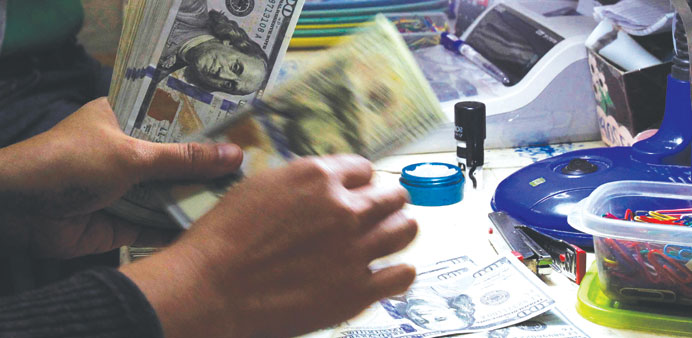A money changer counts US dollar bills at a currency exchange in Manila. After its best quarter against the euro at the start of the year, the dollar weakened in April to June, despite the European Central Bank’s €1tn asset purchase programme and a worsening Greek debt crisis that most investors bet would see the euro dive towards parity with the dollar.
Reuters/London
Howls of anguish from currency fund managers about a lack of volatility have given way to complaints that, while big price swings in exchange rates are back, a directionless market means it is no easier to make money.
An index of global currency managers’ performance, the Parker Global Strategies CMI-C Index, has just recorded its worst quarterly performance since its 2003 launch, losing over 5% in the three months to June.
Just nine months ago, currency fund managers were celebrating the return of the big moves in the FX market on which they depend to make profit, after several years in which central bank cash suppressed volatility and returns.
But though volatility in euro/dollar, the most traded pair, reached a 3-1/2-year high in June and daily moves of 1% or more are now commonplace, most currencies are bouncing around in tight ranges rather than breaking away in any one direction. That gives FX investors a headache.
Paul Lambert’s currency fund at Insight Investment gained 4.7% in the first quarter of the year, as the dollar continued a long-awaited rally begun in mid-2014. But so far this quarter, the fund is down 1.2%.
“When we say (we want) volatility, we don’t really mean volatility,” Lambert said. “The market we’re in now ... is a market in which it’s pretty difficult to make money, unless ... you’re a contrarian day trader.”
FX funds – which make up a very small proportion of the $70tn asset management universe - bet on the direction of exchange rates. But currency movements must be decisive enough to enable investors to ride trends and make decent returns.
After its best quarter against the euro at the start of the year, the dollar weakened in April to June, despite the European Central Bank’s €1tn asset purchase programme and a worsening Greek debt crisis that most investors bet would see the euro dive towards parity with the dollar.
Versus the yen, which many reckoned was due a significant fall, the dollar gained less than 2% in the second quarter, having risen almost 20% in the second half of 2014. Against a basket of currencies, it was the dollar’s worst quarterly performance in almost two years.
“People have in aggregate, either residually or quite purposefully, been long dollar ... so generally we’ve seen people being hurt by the choppiness, the lack of breakouts and the long dollar positioning,” said Anthony Lawler, a portfolio manager who invests in hedge funds at GAM in London.
“Many money managers got caught wrong-footed by the volatility.”
Not all currency investors have relied on a resumption of the dollar rally, which most assume will materialise when the timing of a rise in US interest rates becomes clearer.
“There are still opportunities to make money within this range, as long as the range is broad enough to present dislocational opportunities, for example, in major crosses,” said Ugo Lancioni, head of currency management at Neuberger Berman.
He favoured the yen, in particular against high-yielding commodity currencies such as the Canadian and New Zealand dollars, which he reckons are expensive. And even for dollar bulls, it is not all doom and gloom. Insight’s Lambert reckons its current lack of direction is temporary. “It’s perfectly normal in a trend that you have these periods,” he said.
“The market is pricing in what it thinks is going on, then it tends to overprice it, and then you get some reversal. But the trend can then reassert itself when further evidence comes through to support the initial move.”



